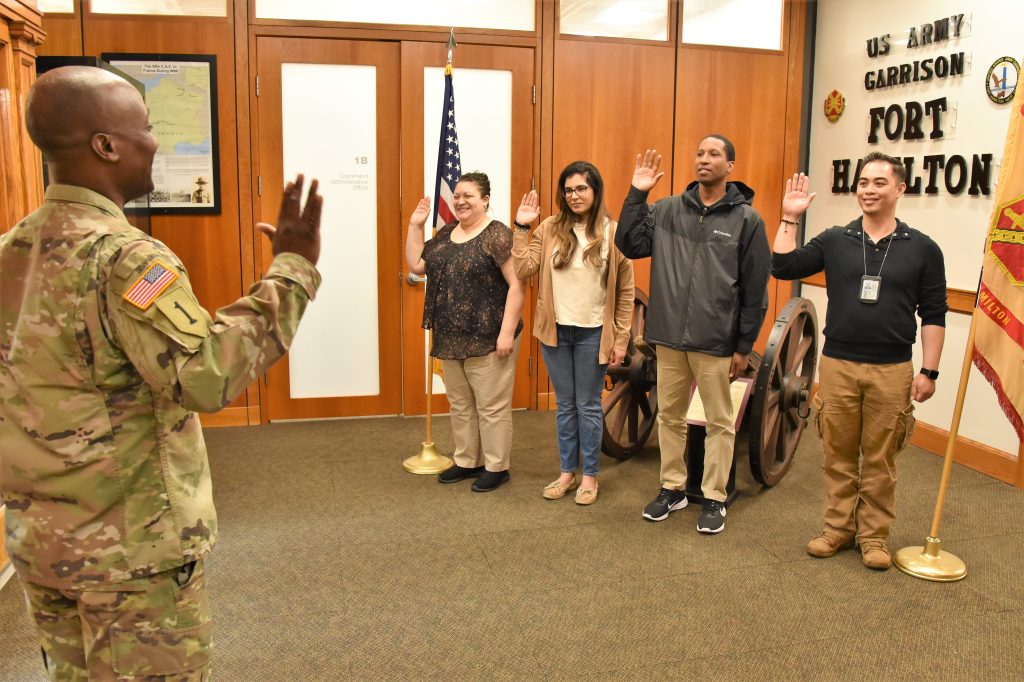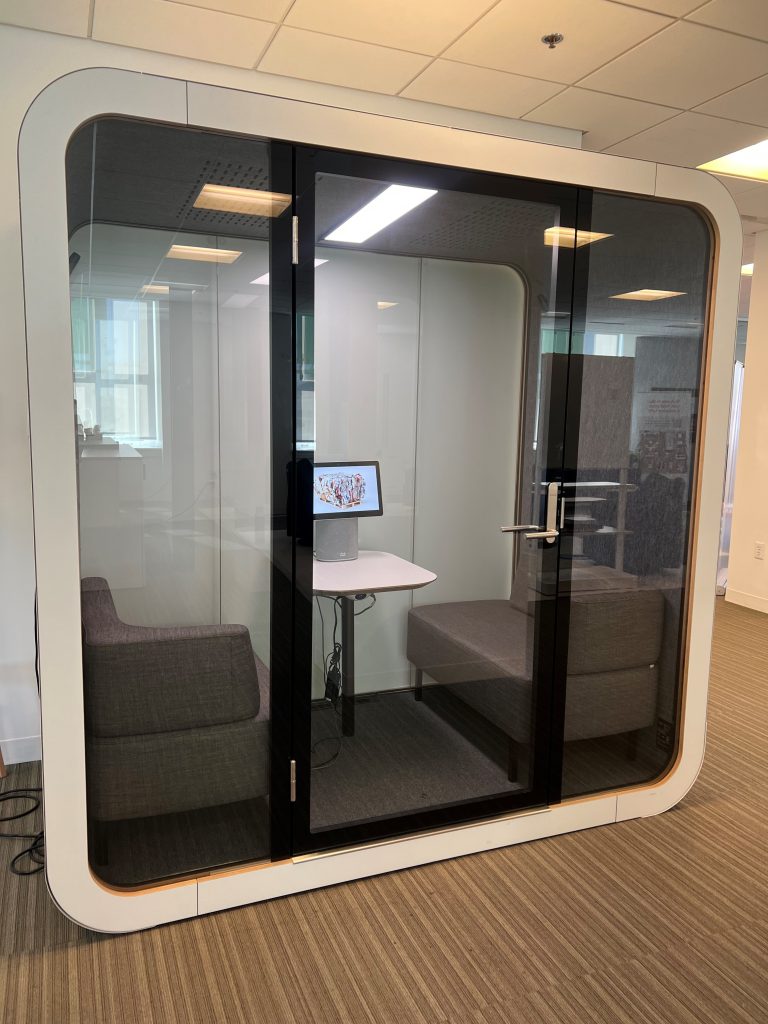
FORWARD FOCUS: There is no one-size-fits-all approach to implementing work flexibility or modernizing the federal workforce. Focusing on the data and how it ultimately impacts the mission will be key for successful implementation. (Photo by Andrea Piacquadio, Pexels)
The Army is rethinking what’s possible to build the workforce of tomorrow and create a workplace that is “a magnet, not a mandate.”
by Ellen Summey
Change is the only constant—but that doesn’t mean it’s easy—and the U.S. Army is no exception. Since the early days of the COVID-19 pandemic, the service has seen seismic shifts in when and where work is being done across the workforce. Many of those changes, like liberal telework policies, remote training opportunities and other flexibilities, are known to be powerful tools for recruitment and retention but are sometimes still met with uncertainty within the service.
“You know, this organization is not used to some of these ideas,” said Brig. Gen. Greg Johnson, adjutant general of the United States Army, United States Army Human Resources Command (HRC). “It’s virtually all new.” If there was one upside to the COVID pandemic, he said, it was that the Army was forced to think through the challenge of remote work and the hurdles to its wide implementation—which Army leaders were not willing to consider before.
DEEP END OF THE TALENT POOL
Today, the Army is making a concerted effort to modernize its workforce, focusing on hiring for in-demand skills and providing additional technical training for existing employees, according to Edward Emden, director of the Army Civilian Career Management Activity (ACCMA) at the U.S. Army Civilian Human Resources Agency. “The Army is looking to recruit more civilians to the workforce in competitive fields such as engineering and cyber,” he said. Emden cited new partnerships with universities and an upcoming advertising campaign for Army civilian careers. “This will be a critical component in raising awareness and understanding the benefits of Army civilian employment to reach a new generation of public servants.”
He also touted new training opportunities for Army civilians across all career fields, provided by his organization. “ACCMA invests in the professional development of all Army civilians by providing access to Udemy for Business, an online learning platform with over 10,000 courses,” he said. “Every Army civilian has access to unlimited courses related to their primary job roles, or something new to upskill or reskill to meet future missions.”
In addition, Emden said the Army can use work flexibilities to be more competitive in the talent marketplace and to remain prepared to continue operations in any future crisis. “Telework and remote work can be powerful tools for the Army civilian workforce because they allow us to remain competitive in recruitment and retention of great talent. Also, it provides resilience in the event of another national emergency, however it must be balanced with the needs of the Army warfighting mission.”
For Johnson, remote work and telework have been effective ways to expand the talent pool for HRC, particularly because of its location in Radcliff, Kentucky. The command works with specialties like human resources, data, information technology (IT), social media and more, he said. “Some of that talent is not necessarily going to be resident in this part of the country.” Attracting that talent requires a new approach, Johnson said. “The old-school way would be, ‘Hey, move to Radcliffe. No ifs, ands or buts.’ You wouldn’t necessarily have that rich opportunity to pull in talent from other parts of the country.”
For one salient example, Johnson pointed to the director of the innovation cell at HRC, Col. Kristin “Kris” Saling. She is an active-duty officer who was ready to retire from the service when Johnson offered her a remote opportunity. “We’ve facilitated her staying in the Army by allowing her to kind of remote in to her job here at HRC,” Johnson said. “We probably would have lost her if we hadn’t facilitated that.” Remote work for civilians is one thing, but remote work for a service member is another thing entirely. Because HRC deals with IT and high-tech solutions, Johnson said the work is a good fit for remote personnel, but he recognizes that this is not the case in many parts of the Army. “If you’re on the line in a squad in the United States Army or you’re in a tank, you’re not remote working,” he said. “But office work, tech work, knowledge work, there’s definitely an ability—and for me, I just think it’s a necessity.”

CLOSING THE GAP: The Army is modernizing its workforce by focusing on hiring for in-demand skills and providing additional technical training for existing employees, especially in fields like engineering and cyber. This is crucial for attracting a new generation of public servants to Army civilian employment. (Photo by Mark Getman, U.S. Army Garrison Fort Hamilton)
ROAD MAP TO 2030
Like many Army commands, Johnson and HRC are working toward their workforce vision for 2030, which they call “HRC 2030.” The plan involves upskilling the HRC workforce on data, IT and analytical skills, as well as updating hiring and work flexibilities. “We think it’s really important, with that vision, that you open up how you hire, and you offer more remote work to draw in the talent needed to modernize the organization and then also allow for some of the remote [work] for specialties in our green-suit population, our uniformed population,” he said. Johnson said he also plans to have more remote workers in the coming years, based on strategic priorities for the command.
According to federal workforce expert Mika Cross, work flexibility can be a powerful tool for building the workforce of 2030. Cross, who served as both an enlisted Soldier and an officer in the U.S. Army, has since worked with teams across the federal government and private industry, advising Fortune 500 companies, nonprofits, academia and startups to leverage work flexibility to create a competitive advantage. Kiran Ahuja, director of the U.S. Office of Personnel Management, testified in March 2023 that remote jobs listed on USAJobs.gov receive an average of 17 times more applicants than nonremote roles. “There really is a significant impact when you’re thinking about filling critical talent shortages,” Cross said.
For leaders contending with a competitive labor market, Johnson offered two pieces of advice. “If you’re in a war for talent and you’re in a very tight recruiting market, then you have to do things that meet people on their own terms,” he said. Part of that should involve crafting an effective engagement strategy. “You’ve got to explain what we’re doing.” Many Americans don’t have a clear idea of the types of jobs that exist within the Army, he said. “There’s always a surprise as I start to talk to folks about our work on systems, IT architecture or social media and how we did the largest implementation of PeopleSoft in the world,” he said. “They go, ‘You’re doing that in the Army?’ Yes, we’re doing that in the Army.”
According to Johnson, the second major challenge is that Army leaders should ensure they are taking charge of their own education and staying abreast of the latest developments and ideas in their respective fields. “If we’re going to keep up, if we’re going to modernize, if we’re going to attract the best talent for the Army, we have to do that.” His directorate has created recommended reading lists for new concepts, data analytics, customer service and more, to foster continuous learning. (See the Adjutant General Directorate’s essential reading guide.)
|
WHERE THERE’S A ‘WIL’ The GSA, commonly known as the federal government’s landlord, is currently conducting a pilot with six federal coworking spaces across the U.S. and a Workplace Innovation Lab in Washington, where feds are invited to schedule tours and test out some of the newest office technology available—from the actual IT and communication systems all the way down to the furniture and even the wiring in the ceiling. Scott Morin is a tech expert who demonstrates the IT capabilities at the lab, which the team often refers to as “the WIL.” “The Workplace Innovation Lab is actually a new environment that GSA created as part of their Workplace 2030 strategy,” Morin said. “And really, it’s grown bigger than we ever thought. Now, we’ve had since February [2023], probably 5,000 to 6,000 federal employees through this space.” Morin said the WIL fills an important role for the federal government, as many organizations embrace a hybrid work environment. “The Workplace Innovation Lab has enabled us to kind of create a magnet, as people are figuring out, how to make the office a magnet versus a mandate.” What will you see when you walk through the front door? “You’re going to see an office that’s different than any other federal office you’ve seen before,” Morin said. “There are a lot of different spaces, very open, flexible spaces for people to collaborate, and we have flexible technology, including video endpoints that can be moved to position based upon your meeting or your group activity.” In terms of federal workspaces, the WIL is unique. It has digital signage and maps, along with a mobile app to reserve a working space and even real-time monitoring of room temperature, air quality and more. “We have, often, 200 to 300 people coming through the space every week, and the feedback that we’ve been given is that this is spot-on for what the government needs to attract people back to the office,” Morin said.  BANISH BACKGROUND NOISE: Taking a video call in a noisy office can be a headache. Background noise may make it difficult for others to hear you on the call—a problem that is compounded when officemates have simultaneous meetings. A visit to the WIL offers the chance to test out several types of soundproof workspaces. (Photo by the author) |
A CHANGING WORKFORCE
Though it has dominated the headlines, COVID was not the only factor precipitating the changes in work flexibility in the U.S. “It is important to keep in mind that there were a few other changes that happened around the same time as the COVID-19 pandemic, but actually have nothing to do with COVID,” said John O’Duinn, an expert on distributed teams and a senior adviser for the U.S. General Services Administration (GSA). “One is a generational change. In 2016, millennials became the largest segment of the U.S. workforce. In 2021, Gen Z, who come after millennials, became the second largest segment of the U.S. workforce. These two segments now make up 57% of the U.S. general workforce.” However, they only account for between 6% and 19% of the federal workforce, depending on certain factors. “By contrast, 45% of our federal workforce are over the age of 50 and 15% of the federal workforce is eligible to retire today,” he said.
Cross agreed that there is room for improvement in the makeup of the federal workforce, and she cited data about women in many roles and career fields. “When you’re thinking about the mission of the Department of Defense and the Army, diverse access to talent is mission-critical,” she said. “In STEM, mission-critical occupations are held by women under 22%, and they are represented at levels of 20% or less in some pockets across the U.S. Army in positions of leadership,” she said. Combining that data with findings from the civilian labor market adds even more nuance. “Lean In’s workplace report on women in the workforce cites that women under the age of 30—who the federal government needs more than anything to come in to the ranks—said that if they saw leadership with the same levels of work-life flexibility that they would want, it would impact their desire to apply and compete for positions of leadership. Seventy-nine percent of them agree with that.”
This is an area where the Army can maximize its return on investment by keeping the focus on the mission, she said. “Let’s face it, the Army gets it when it comes to distributed work and being able to understand the value and benefit of collaboration and working together and leveraging technology for the purpose of distributed teams,” she said. “But people are so wrapped around this concept of, like, how many days is the right mix, or, what does it take to get my people back in the office, rather than focusing on, as Scott [Morin] said, creating the workplace that’s a magnet, not a mandate.”

GETTING THE WORD OUT: Community outreach is a powerful tool for DOD in building connections, dispelling myths and attracting a diverse and committed pool of recruits to serve the nation. It also helps to bridge the gap between military service and the broader community, ultimately strengthening the effectiveness of the armed forces. (Photo by David Poe, Fort Bliss Public Affairs Office)
MAGNETIC MANAGEMENT
So, what’s a manager to do with all this information? What about leaders who aren’t sure where to start, or how to implement work flexibilities? “I would say, ‘Go slow to then go fast,’ ” Johnson advised. “You don’t have to jump in with every single idea that’s out there, or strategy that everybody’s using, but you can slowly work into this and see how it works for your organization, your command.” He said it’s important to understand the needs, preferences and skill sets of your workforce, since they can vary so widely. “You know your team, and some things probably won’t fit nicely in every organization.”
According to O’Duinn, implementing remote-work flexibility also requires an understanding of which roles are location-dependent and which are not—and why. Some employers, he said, are only willing to allow current employees to work remotely after they have proven themselves, but not with recruiting new hires for the same positions. Having a clear shared agreement on which roles are location-dependent versus location-independent can help, he said. “Intentional focus on the recruitment and onboarding processes, as well as intentional mentoring while physically distributed, can also help.”
At HRC, Johnson also plans to rethink how the command hires to make effective use of all the tools at his disposal. “One of the things that we have to organize better is how we recruit talent across the spectrum of eligible folks,” he said. “We’re definitely moving into a heavy use of direct hire authority, which is a great tool.” Using that authority more frequently will facilitate “more remote [opportunities] to support our HRC 2030 strategy,” he said.
The command also aims to demonstrate the successes of Soldiers working remotely, Johnson said. “We had to show Army senior leaders that officers like Kris [Saling] and others could really do what we’re talking about remotely, and I think we’ve been able to do that successfully.” Johnson said it’s possible to retain some Soldiers for longer by offering this flexibility, and HRC has successfully demonstrated over the past year that it provides additional capability to the command.
|
THE COLLABORATION EQUATION How often should remote and hybrid workers come to the office? It’s a question that inspires a lot of debate, so what do the experts say? According to workforce transformation strategist Mika Cross, there is not an ideal tempo for in-person work across the board, but agencies should rely on performance data to make those kinds of decisions. This is in line with an April 2023 memo from the White House Office of Management and Budget, which said that agencies should monitor organizational health and performance indicators—including productivity, efficiency, recruiting and retention—and should adjust workforce policies as needed based on that data. “If your only way to measure productivity is by hours spent at a specified location, then we have a problem,” Cross said of the debate over in-person work for remote and hybrid teams. “We need to measure what matters and we need to be accountable for work being performed, regardless of location.” According to a December 2022 report from the Office of Personnel Management, telework has increased within the federal government and 72% of federal agencies set telework goals to measure impacts on performance indicators, noting increases in human capital goals including employee recruitment, retention, attitudes and reduced employee absences. Cross recently conducted a GovLoop webinar about remote work and hybrid work for federal agencies, teaching leaders to create the infrastructure and capacity to operate more efficiently, and to adopt a flexible mindset to change the organization’s culture from within. Robin C. Kilgore, the deputy assistant director of the Immigration and Customs Enforcement Office of Diversity and Civil Rights, participated in the webinar. She said that managing a virtual work environment is different than managing a team in person, but both require similar skills. “You really need to be looking at the competencies that you want your leaders to have, regardless of where they’re leading, and really help them build that if those skills don’t exist.” Javier Inclan, an assistant inspector general with the National Science Foundation Office of Inspector General, spoke about measuring productivity on 2022 GovLoop event, saying “there is good data to back up what doesn’t need to be done in the office.” He said government leaders “need to get away from that classic ‘line of sight’ management, where we have to see you to know you’re working.”  LET’S TALK TEAMS: Deciding how often workers should be in the office requires a flexible mindset, experts say. (Photo by Fauxels, Pexels) |
TESTING TOOLS AND TECHNIQUES
The GSA is running a federal coworking pilot, testing the concept of shared workspaces for federal employees from any agency, and arranging the floor plan to allow creative and collaborative use of space with standard government furnishings. According to O’Duinn, the agency takes an agile approach to the pilot. “We literally do daily surveys and then we move furniture around, like, ‘OK, try this,’ and then we see what happens for a week or two,” he said. “It’s about more than just moving furniture—people have different styles of working.” A federal coworking space, he said, has to allow for personal interaction while also providing adequate security, a professional environment, reliable internet connection and places to take video calls without being disturbed by others. “That means a different floor plan to what we used to have before,” he said.
The Army is also doing research on its ideal office setup, according to Col. Saling. HRC is looking at how to build a collaborative space, she said, “so that we don’t have an either-or between a cubicle and a kind of noncollaborative conference room.” She cited the command’s desire for more collaborative technology, not just for remote teammates but for working with other agencies as well. “We’ve also gained the ability to pull in our counterpart experts, wherever they might be, so we can do a partner whiteboard with somebody in [Training and Doctrine Command], with somebody in Futures Command, with somebody in D.C., from Fort Knox.”
“It’s really exciting to see how people’s mindsets are shifting,” Cross said of the GSA pilot and similar efforts. “Consider when you’re trying to attract and retain a multigenerational workforce—especially newer careerists and early-career talent—and what that might look like when you have a space that can adapt to people’s preferences, and you have the technology that can serve as an enabler, rather than a distraction,” she said. “Having these kinds of models to adapt will help start changing the culture in very important ways that will impact the future of federal work for a long, long time.”

RECOMMENDED READING: The “Adjutant General Directorate Essential Reading Guide” contains recommended reading lists for new concepts, data analytics and customer service to foster continuous learning. It was created to ensure Army leaders are taking charge of their own education and staying abreast of the latest developments and ideas in their respective fields. (Graphic by Army HRC and USAASC)
CONCLUSION
Though the tools and technology are relatively new, work flexibility has been a part of the federal government for years, Cross said. “Mobility in the federal government—mobile work, telework, flexi-place, remote work, hybrid, or whatever you want to call it because that lexicon evolves—there have been policies in place since the 1950s,” Cross said. The key to successful implementation, in her view, is focusing on the data. “Agencies who are using it as an opportunity to really hone in on the measurement, assessing the data and looking at the impacts to their workforce, doing the right sets of measures, are the ones that are going to have what they need to stand up and say, ‘This matters to our workforce, it impacts our mission, here are the factors that it affects and we’re going to stick with it.’ ”
For the Army, Johnson said there is no one-size-fits-all approach to implementing work flexibility or modernizing the workforce, but the command has partnered with the National Security Innovation Network to help develop an assessment strategy to determine its return on investment. “We’re just nudging into this,” Johnson said. “Our return on investment is, I’m pretty sure this talent right here [Saling] would have been out of the Army. This is just an anecdote because it’s one person, but we feel we’re in a much better spot because [she] is in our innovation cell, really driving productivity.”
For more information about Army HRC, go to hrc.army.mil. Learn more about Mika Cross at mikacross.com. Explore federal coworking at https://workplace.gsa.gov/offerings/federal-coworking/.
ELLEN SUMMEY provides contract support to the U. S. Army Acquisition Support Center at Fort Belvoir, Virginia, as a communications project manager for SAIC. She holds an M.A. in human relations from the University of Oklahoma and a B.A. in mass communication from Louisiana State University. She has earned the Accreditation in Public Relations and Military Communication, is certified as a Project Management Professional and has more than 18 years of communication experience in both the government and commercial sectors.


